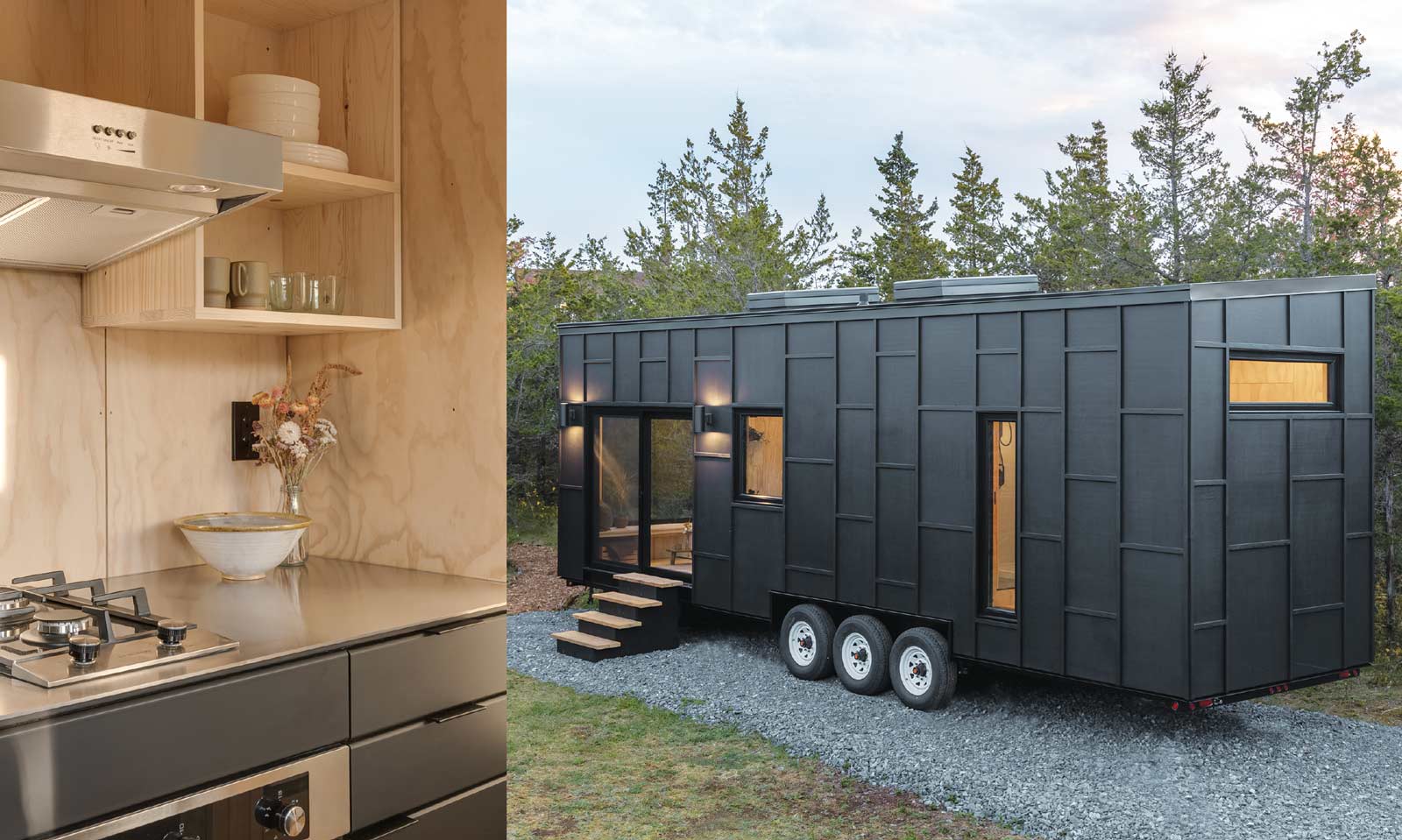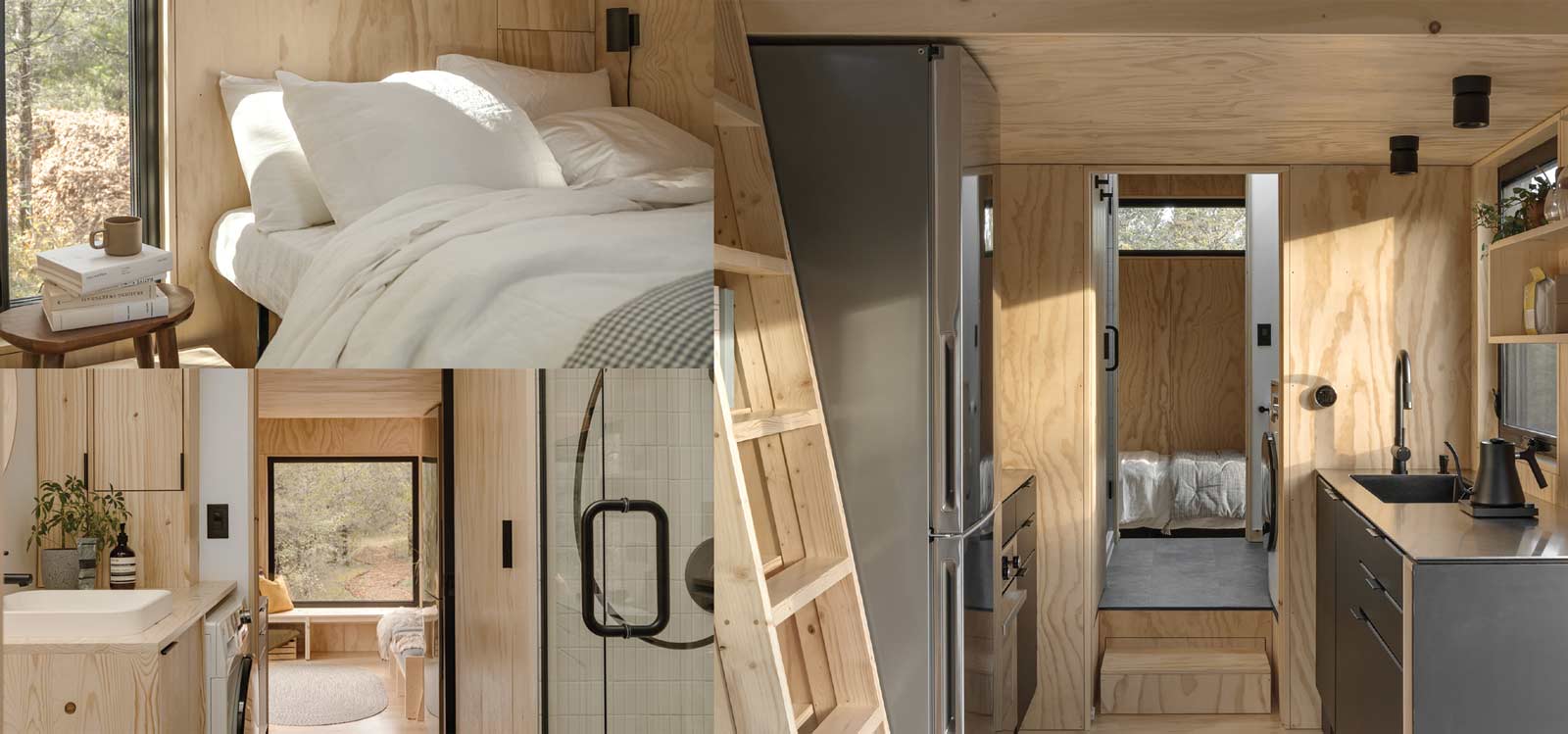

A revolution in tiny home building combines a smaller environmental footprint with an eye to producing much-needed affordable housing.
The architectural lines are clean, the space efficient, the material choices intentional. Soft natural light pours through the many black-framed windows and skylights. The kitchen boasts a full-sized fridge, cooktop and oven, an extra-wide granite sink, stainless steel countertop and storage under the cabinets. The bedroom fits a queen-sized mattress; above it sits a cosy loft. The interior walls are natural pine instead of drywall, and the bathroom boasts a porcelain tiled shower and matte black shower fixtures. The vibe is Scandinavian- inspired design with Japanese minimalist flairs; the space cosy, despite Ontario’s bone-chilling winter. And it all fits into a compact building that is no more than 262 square feet in size.
Meet P01, Instead’s first certified tiny home on wheels.
Measuring 32 feet by 8.5 feet, P01 is certified as an RV, which means it can be set up with water and power and can be parked anywhere a typical RV is allowed. But it feels nothing like an RV.
“Most people are surprised by how big it actually feels; they always expect it to be much smaller,” says Lee Loewen, co-founder and head of Design and Innovation at Bloomfield-based Instead. “But when you step inside, the ceiling heights are so, so high at 13.5 feet, you don’t feel claustrophobic at all.” Adds partner and co-founder Payam Shalchian, head of Business Development, “You’re not sacrificing anything. It’s like you’re inside a condo as opposed to an RV.”
“Most of the benefits come from a change in lifestyle and minimizing possessions,” says Lee, who lives in the P01 with his young family. “The whole philosophy for a lot of people is to downsize the extras in their life, so that they can focus on what’s important to them.”
Tiny homes aren’t exactly new: Henry David Thoreau extolled the virtues of downsized living from his cabin on Walden Pond in the 1840s. More recently, reality shows such as Tiny House Nation, which premiered in 2014, brought forward the stories of everyday people seeking simpler lives in smaller, more affordable spaces. While mainstream building has been trending towards bigger homes – a 2019 Statistics Canada report pegs above-ground single-detached houses at 2,380 sq. ft., 30% larger than those built in the 1980s and 1990s, and twice as large as houses built before 1960 – the tiny house movement advocates for a return to a much, much smaller footprint.
Now entering their second year of business, the team of two are passionate advocates of alternative dwellings, innovative building practices and conscious living. Both come from industrial design backgrounds: Payam moved into management consulting and Lee worked in retail design. Disillusioned by the fast-paced consumerist life of Toronto, Payam moved to 75 acres in the County in 2017 to start The Edward Bed & Breakfast with his partner. During the same time, Lee was researching alternative housing options and efficient space design, even considering a houseboat. Over the years they stayed connected over design and innovative small-scale builds; and then in 2020, with Lee’s help, Payam built one of his own: an 80 sq. ft. minimalist rentable retreat named the Skyward Cabin, constructed with lots of glass and Canadian red cedar.
The province has taken steps to define tiny homes and their construction with the implementation of Bill 108, The More Homes, More Choice Act of 2019.
“We got seriously talking about building more things like that and then in winter 2020 we said, ‘Why don’t we just start a business?’” says Payam. “We thought, we have the business skill sets and the design skill sets to apply to a real problem. We started thinking about the housing industry and how to tackle some of those issues.”
One of those issues is affordability: while the housing market was already soaring out of reach for a growing number of buyers, the pandemic pushed prices to new heights: According to the Quinte & District Association of REALTORS Inc., the benchmark price for single-family homes in December 2021 was $550,800 – up 35% from the previous (and already inflated) December. In Prince Edward County, the residential average price was $804,616.
“I’ve always been of the mindset that people should be able to live within their means, that there should be a possible route for that. And it just seems like there’s very little opportunity for a lot of people,” says Lee.
The P01 base model starts at $150,000, and while not cheap, it gives buyers access to a self-contained house. Living in a tiny home also fosters an intimate connection with the land and the house itself: how much energy and water you use, where your waste water is going. “That’s the conscious living part of our brand,” says Payam. “That’s been big.”
While buyers can choose to go off-grid, like Lee’s P01, Payam cautions, “It is a lifestyle that’s very much romanticized. And it does come at a cost [approximately 30% of the total build], especially if you’re living in a climate like ours.”
Then there’s the elephant in the room: Are tiny homes legal in Ontario? “It’s a very, very convoluted, nuanced conversation right now,” says Payam, “but the change is happening.”
The provincial government has taken steps to define tiny homes and the parameters around their construction with the implementation of Bill 108, the More Homes, More Choice Act of 2019. And although they released the “Build or buy a tiny home” guide that outlines compliance with the Ontario Building Code, each municipality has its own set of regulations and bylaws.
That’s why before giving a thought to design, buyers need to choose their location and know what the bylaws allow. The second step is arranging financing, as conventional mortgages are not currently available for tiny homes (though with the RV certification, Instead’s models may qualify for RV financing). “It’s a more affordable option, but it’s still quite a lot of cash,” says Payam.
The partners recently moved into a new shop, where they have space to build more tiny homes onsite. They also recently announced the P02: based on the certified P01 platform, but with new customizations.
Both Payam and Lee are very clear that tiny homes are just part of a larger ecosystem, and it’s crucial to address the systemic issues around access to housing and creating partnerships with other players, such as financial institutions and insurance providers.
“A lot of institutional change needs to happen to make these kinds of dreams a reality, and the way forward is to have more examples that show that tiny homes can work,” says Payam.
“We don’t necessarily want to say that this is the answer to affordable housing,” adds Lee, “because living in a small space is a big lifestyle change for people and shouldn’t be a person’s only option. But it should be an option as people are willing to or interested in living that way if it aligns with their values.”
Email: hello@instead.works
Story by:
Fiona Campbell
Photography by:
Brooke Stephenson




